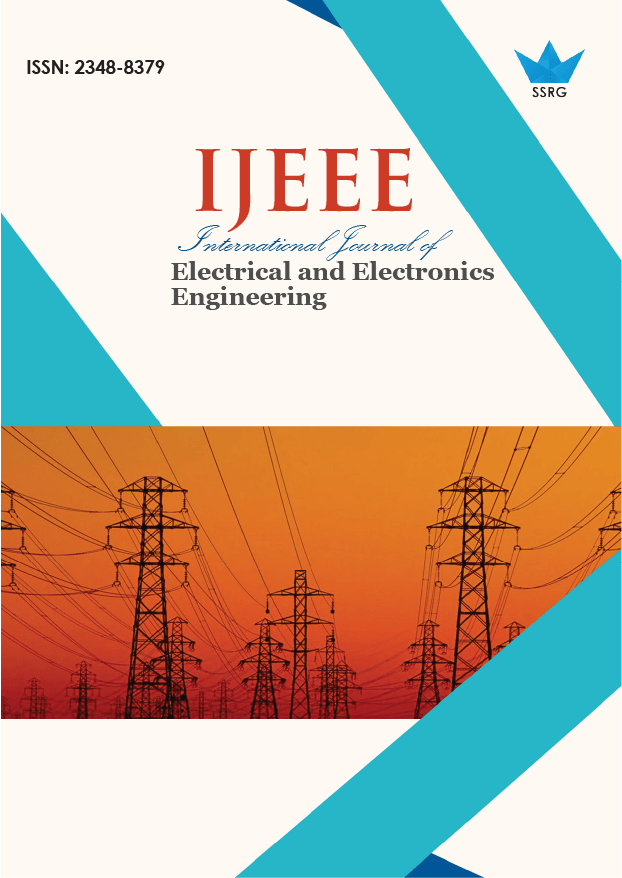Lumped Disturbance Estimation-Based Dynamic Surface Control for 8/6-Type Switching Reluctance Machines

| International Journal of Electrical and Electronics Engineering |
| © 2024 by SSRG - IJEEE Journal |
| Volume 11 Issue 12 |
| Year of Publication : 2024 |
| Authors : Thuy Vo Thi Cam, Dzung Manh Do, Khoat Nguyen Duc, Phan Xuan Minh |
How to Cite?
Thuy Vo Thi Cam, Dzung Manh Do, Khoat Nguyen Duc, Phan Xuan Minh, "Lumped Disturbance Estimation-Based Dynamic Surface Control for 8/6-Type Switching Reluctance Machines," SSRG International Journal of Electrical and Electronics Engineering, vol. 11, no. 12, pp. 100-107, 2024. Crossref, https://doi.org/10.14445/23488379/IJEEE-V11I12P109
Abstract:
This paper concentrates on two problems in controlling the 8/6-type Switching Reluctance Motors (8/6-type SRMs or SRMs for short) in the presence of unknown external disturbances and uncertain factors. The first is studying the stabilization problem for SRMs’ rotational speed, and the other is the disturbance rejection. The stabilization issue for SRMs’ velocity is known as steering the rotational speed to be stable at the desired value, which is chosen arbitrarily, while disturbance rejection’s primary mission is to eliminate external disturbances that harm SRMs’ control performance. The first problem is handled by Dynamic Surface Control (DSC), in which the Low-Pass Filter (LPF) is integrated into the control scheme to perform the derivative operation of virtual control signals. This feature helps to reduce the computational burden and avoid the undesired phenomenon called "explosion of terms". The external disturbances presenting during the SRMs’ operation are compensated via an online training Radial Basis Function (RBF) neural network. The control cooperation regime between the DSC and the proposed neural network for uncertain SRMs lifts the control performance compared to the traditional DSC. The effectiveness of contributions and control schemes is demonstrated through impressive mathematical proofs and numerical simulation platforms.
Keywords:
Switching Reluctance Motor, Dynamic Surface Control, Disturbance compensation, Neural network.
References:
[1] Gerasimos Rigatos, Pierluigi Siano, and Sul Ademi, “Nonlinear H-Infinity Control For Switched Reluctance Machines,” Nonlinear Engineering, vol. 9, no. 1, pp. 14-27, 2019.
[CrossRef] [Google Scholar] [Publisher Link]
[2] JIn-Woo Ahn, Switched Reluctance Motor, Torque Control, pp. 201-252, 2011.
[CrossRef] [Google Scholar] [Publisher Link]
[3] Ramu Krishnan, Switched Reluctance Motor Drives: Modeling, Simulation, Analysis, Design, and Applications, 1st ed., CRC Press, Boca Raton, 2017.
[CrossRef] [Google Scholar] [Publisher Link]
[4] Jiajun Wang, “Speed-Assigned Position Tracking Control of SRM with Adaptive Backstepping Control,” IEEE/CAA Journal of Automatica Sinica, vol. 5, no. 6, pp. 1128-1135, 2016.
[CrossRef] [Google Scholar] [Publisher Link]
[5] Xiaodong Sun, “Optimal Design of Terminal Sliding Mode Controller for Direct Torque Control of SRMs,” IEEE Transactions on
Transportation Electrification, vol. 8, no. 1, pp. 1445-1453, 2021.
[CrossRef] [Google Scholar] [Publisher Link]
[6] Muhammad Rafiq et al., “A Second Order Sliding Mode Control Design of a Switched Reluctance Motor using Super Twisting Algorithm,” Simulation Modelling Practice and Theory, vol. 25, pp. 106-117, 2012.
[CrossRef] [Google Scholar] [Publisher Link]
[7] Phi Hoang Nha et al., “Backstepping Control using Nonlinear State Observer for Switched Reluctance Motor,” Vietnam Journal of Science and Technology, vol. 60, no. 3, pp. 554-568, 2022.
[Google Scholar] [Publisher Link]
[8] Y. Boumaalif, and H. Ouadi, “A Nonlinear SRM Controller Design for Torque Ripple Reduction with Accounting for Magnetic Saturation,” IFAC-PapersOnLine, vol. 55, no. 12, pp. 240-245, 2022.
[CrossRef] [Google Scholar] [Publisher Link]
[9] Liyun Feng et al., “A Review on Control Techniques of Switched Reluctance Motors for Performance Improvement,” Renewable and Sustainable Energy Reviews, vol. 199, 2024.
[CrossRef] [Google Scholar] [Publisher Link]
[10] Ali Bouklata et al., “Advanced Control Strategy of Switched Reluctance Generator-Based Wind Energy Conversion Systems Using Backstepping and Extremum Seeking Techniques,” IFAC-PapersOnLine, vol. 58, pp. 13, pp. 593-598, 2024.
[CrossRef] [Google Scholar] [Publisher Link]
[11] Xiaodong Sun et al., “Position Sensorless Control of SRMs Based On Improved Sliding Mode Speed Controller and Position Observer,” IEEE Transactions on Industrial Electronics, vol. 72, no. 1, pp. 100-110, 2025.
[CrossRef] [Google Scholar] [Publisher Link]
[12] Jundi Sun et al., “Sliding Mode-Observer-Based Position Estimation For Sensorless Control of the Planar Switched Reluctance Motor,” IEEE Access, vol. 7, pp. 61034-61045, 2019.
[CrossRef] [Google Scholar] [Publisher Link]
[13] Phi Hoang Nha et al., “Backstepping Control using Nonlinear State Observer for Switched Reluctance Motor,” Vietnam Journal of Science and Technology, vol. 60, no. 3, pp. 554-568, 2022.
[Google Scholar] [Publisher Link]
[14] Arun Chithrabhanu, and Krishna Vasudevan, “Current Sharing Function Based Torque Ripple Reduction Strategy for Switched Reluctance Motor Drives,” In 2021 IEEE 12th Energy Conversion Congress & Exposition Asia (ECCE-Asia), Singapore, pp. 2381-2386, 2021.
[CrossRef] [Google Scholar] [Publisher Link]
[15] Ali Abdel-Aziz, Mohamed Elgenedy, and Barry Williams, “Review of Switched Reluctance Motor Converters and Torque Ripple Minimization Techniques for Electric Vehicle Applications,” Energies, vol. 17, no.13, pp. 1-26, 2024.
[CrossRef] [Google Scholar] [Publisher Link]
[16] Hüseyin Çalik et al., “A Study on Torque Ripple Improvement Compared to a Modified Rotor and Stator Poles SRMs with Classical SRMs using Dynamic and FFT Analysis,” Electric Power Components and Systems, vol. 51, no. 13, pp. 1328-1337, 2023.
[CrossRef] [Google Scholar] [Publisher Link]
[17] Dingxin He, Haoping Wang, and Yang Tian. “Model Free Prescribed-Time Control Under Input Amplitude and Rate Saturations for Uncertain Mechatronic Systems with Mismatched Disturbances”. IEEE Transactions on Circuits and Systems II: Express Briefs, vol. 71, no. 1 pp. 201-205, 2024.
[CrossRef] [Google Scholar] [Publisher Link]
[18] Afshin Izadian, Fundamentals of Modern Electric Circuit Analysis and Filter Synthesis, A Transfer Function Approach, 2nd ed., Springer, 2019.
[CrossRef] [Google Scholar] [Publisher Link]
[19] J.C. Das, Power System Harmonics and Passive Filter Design, IEEE Press and Wiley, 2015.
[CrossRef] [Google Scholar] [Publisher Link]
[20] Haijiao Yang, and Dan Ye, “Adaptive Fixed-Time Bipartite Tracking Consensus Control for Unknown Nonlinear Multi-Agent Systems: An Information Classification Mechanism,” Information Sciences, vol. 459, pp. 238-254, 2018.
[CrossRef] [Google Scholar] [Publisher Link]
[21] Shuang Cong, and Yang Zhou, “A Review of Convolutional Neural Network Architectures and Their Optimizations,” Artificial Intelligence Review, vol. 56, no. 3, pp. 1905-1969, 2023.
[CrossRef] [Google Scholar] [Publisher Link]

 10.14445/23488379/IJEEE-V11I12P109
10.14445/23488379/IJEEE-V11I12P109